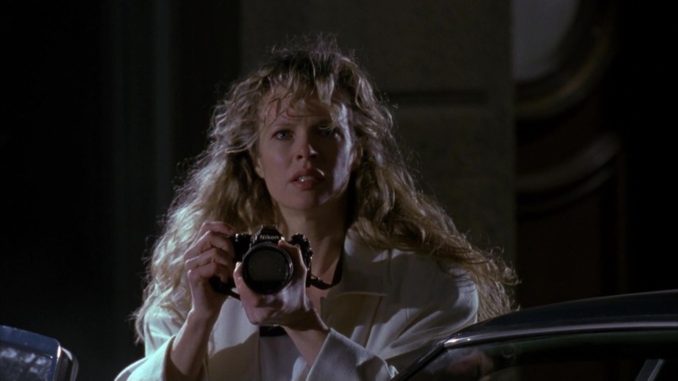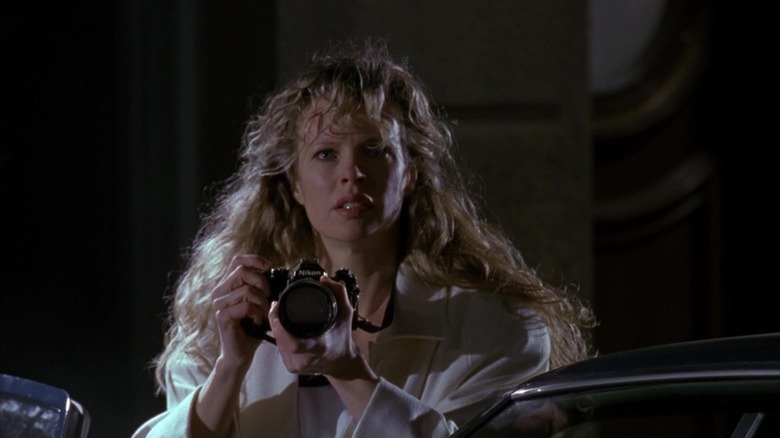
In the “Batman” comics, Vicki Vale has almost always been just a love interest for the titular caped crusader. The Alan Grant/Norm Breyfogle era of these comics saw Vale embody some agency, with a focus on her skills as a competent Gotham photojournalist. However, traditional interpretations of Vale are that of a damsel in distress or a vehicle for Batman to tussle with his fractured identity. She’s meant to highlight how heroic Batman is, which is contrasted with Bruce Wayne’s inability to be honest and vulnerable with someone who only knows half of him. The only exception to this treatment in the comics is 2009’s “Batman: Battle for the Cowl,” where Vale figures out the Batman-Bruce connection and plays a seminal role in uncovering the truth about Two-Face’s nefarious plans for Gotham City.
When Tim Burton honed in on Vicki Vale for 1989’s “Batman,” it was an opportunity to reinvent this oft-sidelined character. Kim Basinger brought Vale to life, investing her with the courage and resourcefulness expected of someone of her profession. During the course of her investigation, she is caught between two men who harbor different kinds of obsession: Bruce Wayne/Batman (Michael Keaton) and Jack Napier/The Joker (Jack Nicholson). While Batman and The Joker are enamored by what Vale represents, this animosity truly boils down to their clashing ideals, even though both men are social outcasts. Vale is also the catalyst for the climactic cathedral fight in “Batman”, which (yet again) casts her in the mold of a damsel in need of saving.
The reasons why Vale feels like a passive character when compared to the men around her can be attributed to a last-minute casting that prompted major script rewrites. Basinger wasn’t the first choice for the role, as Sean Young was initially cast as the smart, gutsy photojournalist devoted to unmasking Batman. What exactly happened here?
Sean Young had an accident on the set of Tim Burton’s Batman
When she was cast as Vicki Vale in “Batman,” Sean Young was fresh off the success of “Blade Runner” and “Wall Street,” and had starred as Chani in David Lynch’s rendition of “Dune.” This was also a fan-favored casting, as Young had repeatedly proven herself capable of tackling roles of a similar variety (especially in stories with a dramatic heft, such as “No Way Out.”) Moreover, nabbing one of the leading roles in a film that would go on to alter the industry’s attitude towards comic book adaptations comes with its own weight and perks. However, Young was deprived of this opportunity after she had a serious on-set horseback accident, after which she had to be replaced on very short notice.
A version of the script for “Batman” (written by Sam Hamm and Warren Skaaren) set up an action sequence with Vale on horseback, and Young was practicing her horse-riding during rehearsals a few weeks before filming began. During one such practice session, she was unfortunately thrown off, and her arm got fractured. This is what Young had to say about the accident and its aftermath in a 2021 interview with The Daily Beast:
“I broke my arm. They did spring the horse-riding thing on me, and I fell and had an accident. Could they have kept me on the show and shot around my arm? They probably could have […] But it is what it is. I had an accident and then got walked to the door.”
With very little time to cast someone else who was fit for the role, Burton and the producers scanned through the list of available (and interested) actors and went with Basinger, who had just starred in Robert Benson’s “Nadine.” The horse-riding scene, which was initially intended as a romantic moment between Bruce Wayne and Vale, was cut altogether, and any follow-up sequences were also altered.
While horse riding might seem out of place in the version of the film we know and love, it isn’t such a farfetched idea. After all, Frank Miller’s genre-altering 1986 DC Comics miniseries, “The Dark Knight Returns,” etches an enduring image of Batman riding a horse to battle. Miller’s work served as a seminal influence on Burton’s film, as it was one of the first comic series to flesh out Batman’s darker, messier psychological impulses.



Leave a Reply